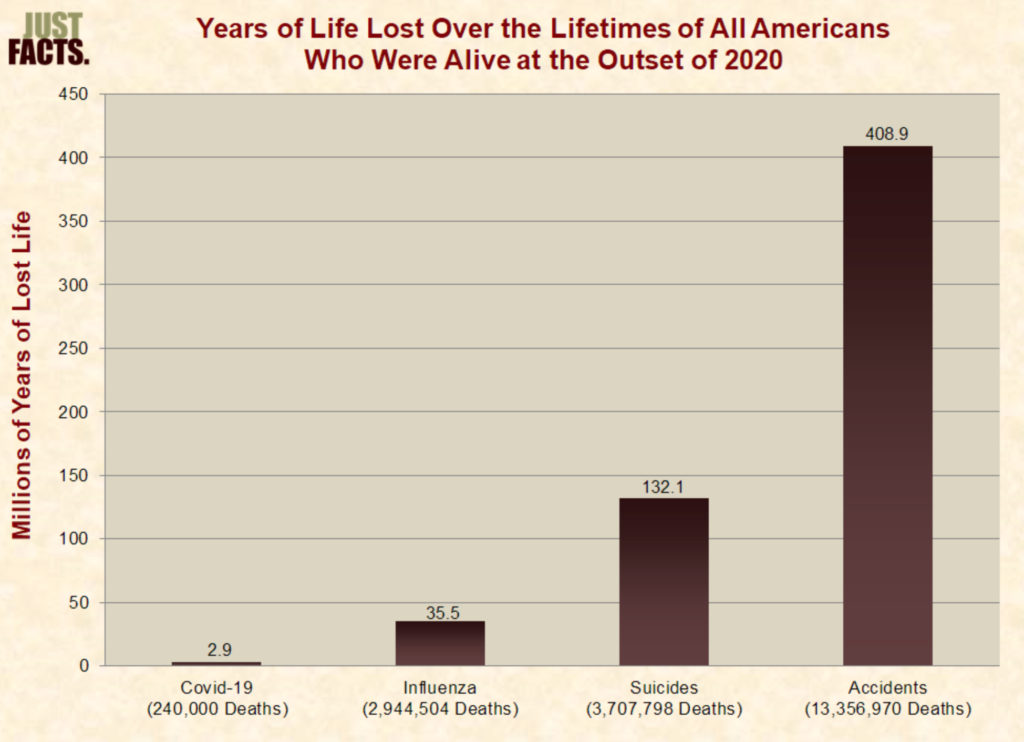Posted 17 May 2020

I was intrigued by comments made by Dr Mike Ryan of the WHO on Wednesday. When asked about the possible role of herd immunity in dealing with COVID19, “Humans are not herds”, was apparently his rather hostile response.
Herd immunity emerged from veterinary epidemiology, typically involving business decisions as to whether animals should be left to die for the overall health of the herd. “An individual animal in that sense does not matter, from the perspective of the brutal economics of that decision making.”
Ryan suggested that the term should therefore be used very cautiously when talking about infection in human populations because it implies very brutal arithmetic. It does not put people and life at the centre of the equation.
Maybe as a statistician I am more able to focus on the ‘arithmetic’ and forget the word ‘brutal’: Just do the numbers and let others worry about the emotion.
The first graph attached to this post is an estimate of ‘years of life lost’ in the U.S. due to COVID19 during the whole of 2020 (based on a predicated total US death total of 240,000). The graph also shows predicted years of live lost due to influenza, suicides and accidents.
[Just to clarify the metric here, ‘years of life lost’, is a measure often used by insurance companies and those budgeting health resources, to show how many more years a person would have expected to live if they had not succumbed to a particular malady].
The comparatively small result for COVID19 – 2.9 million years – is driven by the median age of COVID19 deaths being around 80-81; the average age of deaths from influenza, suicides and accidents is much lower and so the potential lost years are much higher. You will notice that even in a COVID year, there are still going to be significantly more deaths from these other causes too, all compounding to make the ‘years of life lost’ estimates much higher for these other mortalities.
But the statistics in this graph are changing as politicians dither over how and when to ease lockdown.
Medical studies show that excessive stress and anxiety are among the most debilitating and deadly of all health hazards in the world. Suicide and substance abuse are the obvious consequences but all causes of stress and anxiety are strongly related to and may trigger worsening of many chronic metabolic and mental conditions. The medical literature has many studies looking at consequential deaths from stressors. Many of these are really quite sobering even for my brain somewhat de-sensitised by the death numbers from COVID19.
The reactions to COVID19, both by the individual and by Governments, are creating a second pandemic of stress and anxiety. For example, the American Psychiatric Association published data in mid March showing that 36% of adults reported anxiety over COVID19 that was impacting their mental health. The Kaiser Family Foundation reported by the end of April that 56% of adults were recording worry and stress related to COVID19. This was manifesting as “trouble sleeping, poor appetite or over-eating, frequent headaches or stomach aches, difficulty controlling their temper, increasing their alcohol or drug use and worsening chronic conditions like diabetes or high blood pressure.”
So, as the politicians and union leaders continue to squabble over whether it is ‘safe to come out now’, those left at the coal face of rational analysis have to weigh benefits and harms. Cowering in lockdown is of diminishing benefit and yet prolonging it seemingly creates escalating harm.
A study I saw today has begun to estimate the future lives lost to COVID19 – businesses and economies in shutdown, media exaggerations, isolation from stay-at-home orders will fuel stress and anxiety. The deaths and consequent ‘years of life lost’ are set to rise and unlike the cumulative case and death curves from COVID19, the curve of these stress and anxiety deaths has only just begun..
The study estimates that the years of life lost due to lockdown and our reactions to it will be at least seven times the years of life lost directly due to the virus. And the study authors consider that a very conservative estimate.
So maybe focussing on total deaths from COVID is misleading. Even the CDC admits that “years of life lost” is an important metric when looking at how health resources are allocated. It recognises that humans cannot prevent death, merely delay it and that there is a material difference between a malady that kills a 20 year old in the prime of her life and one that kills a 90 year old who could have died a month later.
Brutal arithmetic for the human herd.
Politicians are caught in the arithmetic too: They insist on continuing with lockdowns for fear of the blood on their hands should a second wave of cases appear on easing restrictions. But, and to pick up Ryan’s point at the start of this piece, this strategy whilst putting people and life at the centre of part of the equation, it ignores the future people and lives in the other as yet unseen half of the equation. But as that won’t be blood on the hands of today’s decision makers, it is easy to ignore.
“The operation was a success, but the patient died”. Let that not be the epitaph of lockdown.
